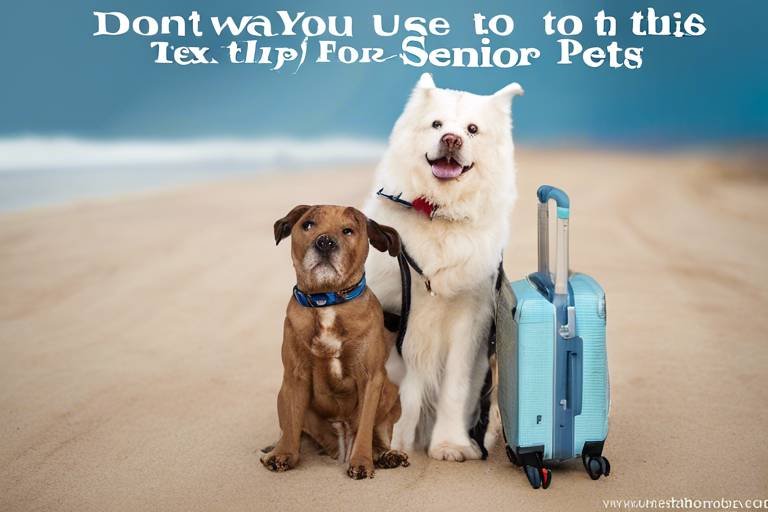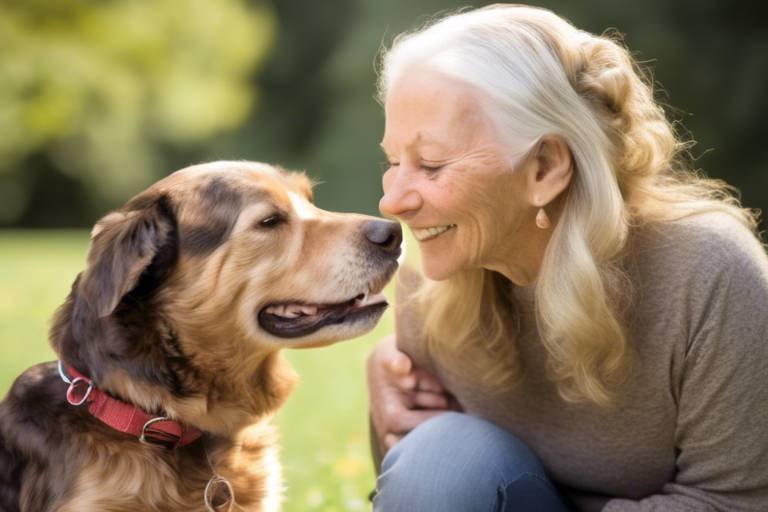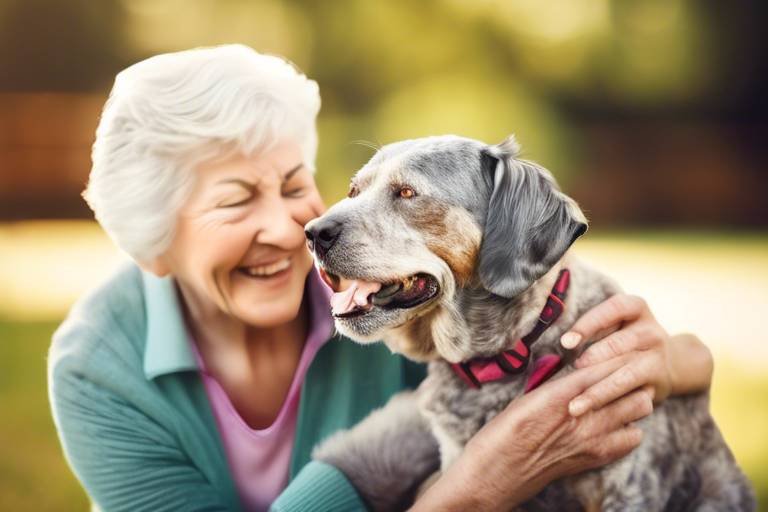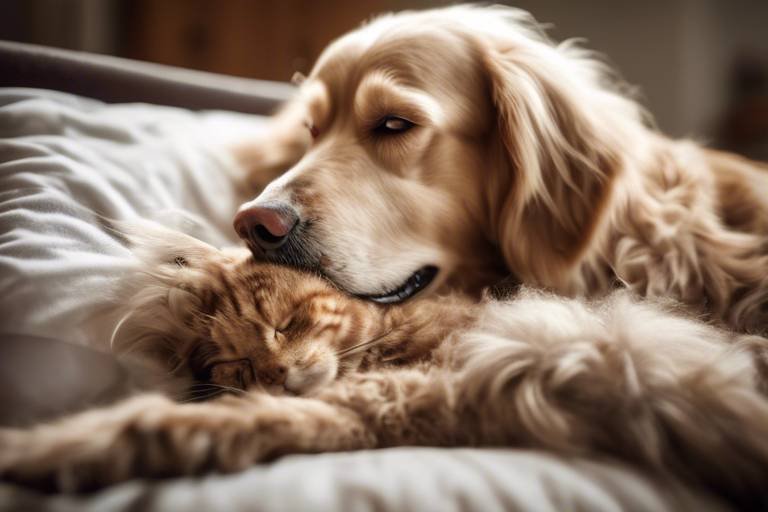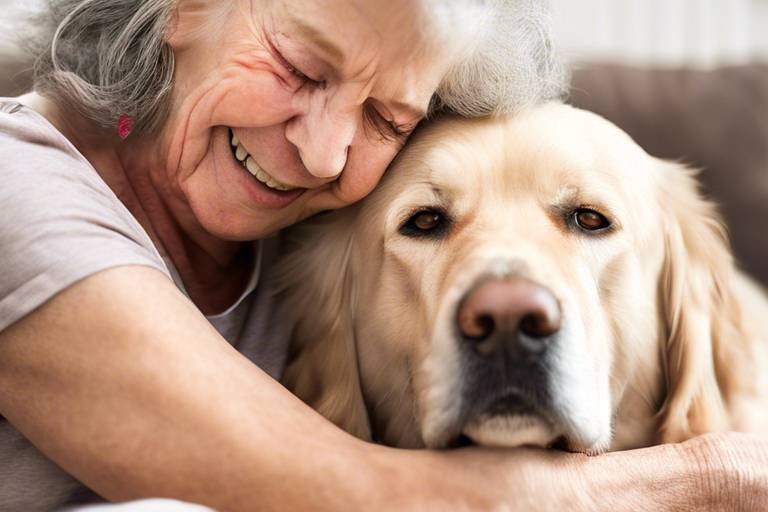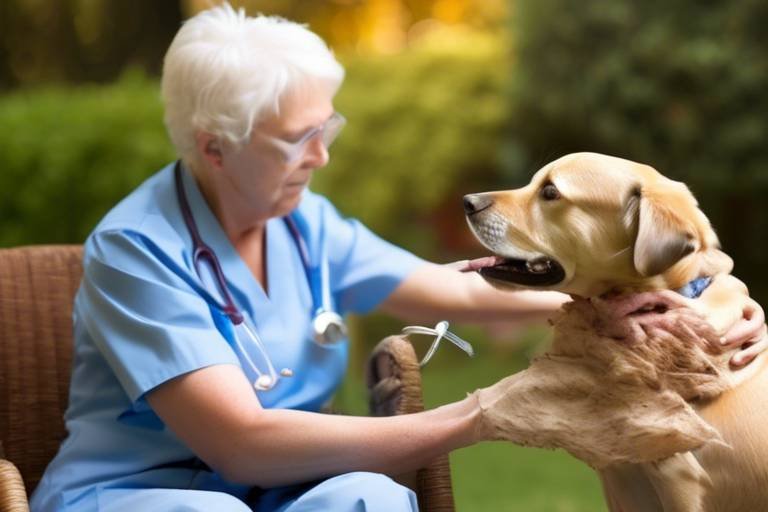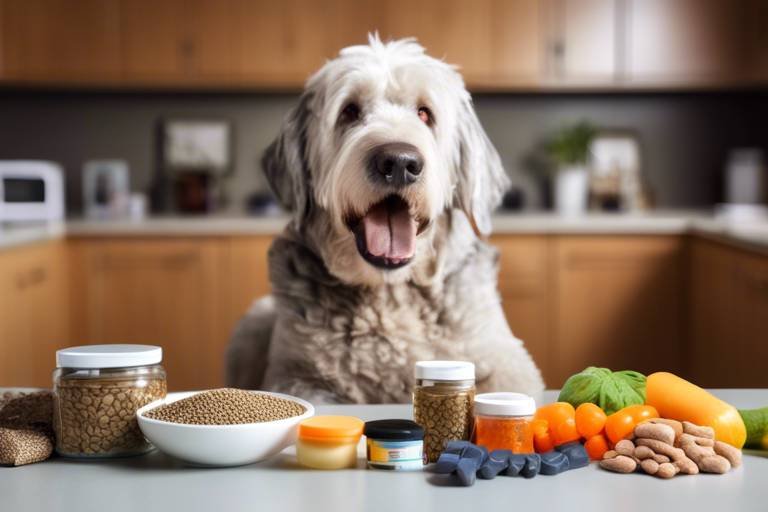Tips for Traveling with Senior Pets
Traveling with our furry companions is one of life's greatest joys, but when it comes to senior pets, the journey can require a bit more thought and care. Just like humans, our older pets have specific needs that must be addressed to ensure they remain comfortable and safe throughout the trip. Whether you're planning a road trip or a weekend getaway, understanding these needs is crucial for a stress-free experience for both you and your beloved senior pet. In this article, we’ll dive into essential tips and tricks that will help you prepare for the journey ahead, ensuring that your senior pet enjoys the adventure just as much as you do.
As our pets age, their physical and emotional needs evolve. Senior pets may experience a range of health issues, including arthritis, decreased vision, and dental problems. Recognizing these changes is vital for keeping them comfortable during travel. For instance, a pet that used to jump into the car with ease may now need a little help. Additionally, older pets often experience anxiety, especially in unfamiliar environments. It’s important to provide emotional support by keeping their favorite toys or blankets close by. This familiarity can help ease their nerves and make the journey more enjoyable.
Preparation is the key ingredient for a successful trip with senior pets. Before you hit the road, take the time to ensure you have everything you need. Start by scheduling a veterinary check-up to confirm your pet is fit for travel. This visit can identify any potential health issues that could arise during your journey. Additionally, make sure to pack all the essentials, including food, water, medications, and any necessary health documents. Don’t forget to plan for regular breaks during your trip; senior pets often need more frequent stops to stretch their legs and relieve themselves.
Scheduling a veterinary visit prior to traveling is crucial. This check-up can help identify any underlying health issues that may not be immediately apparent. It's also an excellent opportunity to discuss travel plans with your vet, who can provide tailored advice for your pet's specific needs. Remember, peace of mind is invaluable when you're on the road!
Updating your senior pet's vaccinations is essential, especially if you’re traveling to areas where they may be exposed to new diseases. Make sure to pack their medications and follow the prescribed schedule while on the road. If your pet requires specific medications, consider creating a travel medication schedule to keep everything organized. This ensures that your furry friend stays healthy and happy during your travels.
Maintaining your senior pet's diet while traveling is crucial for their health. Changes in diet can lead to digestive issues, which are especially concerning for older animals. Stick to their usual food as much as possible, and pack enough for the duration of your trip. If you’re traveling long distances, consider bringing along a cooler to keep their food fresh. Additionally, plan feeding times around your travel schedule to maintain routine and comfort.
Car travel can present unique challenges for senior pets. To create a comfortable environment, consider using a pet seatbelt or carrier to keep them secure during the ride. This not only protects them but also minimizes distractions for the driver. Ensure that the temperature inside the vehicle is comfortable, as older pets are more sensitive to heat and cold. A cozy blanket can also provide them with a familiar and comforting space during the journey.
Finding suitable accommodations is essential for a stress-free trip. When searching for pet-friendly hotels, look for places that specifically cater to senior pets. These establishments often provide amenities designed to make your pet's stay as comfortable as possible. Consider factors such as accessibility and the availability of outdoor spaces for easy bathroom breaks.
Accessibility is a crucial factor when selecting accommodations. Ensure that the place you choose has easy access for senior pets. Look for hotels that offer ground floor rooms or elevators to avoid stairs that may be difficult for your pet to navigate. This small consideration can make a huge difference in your pet's comfort level.
Bringing familiar items can help reduce anxiety for your senior pet. Pack their favorite toys, bedding, or even a piece of your clothing to create a comforting space in your temporary lodging. Familiar scents can help ease the transition and make your pet feel more at home, reducing stress during your travels.
Comfort is paramount for senior pets during travel. Maintain a soothing environment by controlling the temperature in your vehicle and accommodations. Provide cozy bedding for rest, and make sure they have a designated space where they can retreat when feeling overwhelmed. Regular breaks are essential, too; not only do they allow your pet to relieve themselves, but they also provide opportunities for exercise and stretching.
Frequent breaks are essential for senior pets to stretch and relieve themselves. Plan regular stops during your journey to keep your pet active and comfortable. During these breaks, encourage your pet to walk around and hydrate. This not only keeps them physically healthy but also mentally stimulated, making the journey more enjoyable.
Travel can be stressful for pets, especially seniors. Keep an eye out for signs of stress, such as excessive panting, whining, or hiding. If your pet seems anxious, try to calm them with gentle petting or soothing words. Creating a calm atmosphere during travel can significantly reduce their stress levels, making the journey more pleasant for everyone involved.
- What should I pack for my senior pet? Be sure to include food, water, medications, bedding, and favorite toys.
- How often should I take breaks during travel? Plan to stop every 2-3 hours to allow your pet to stretch and relieve themselves.
- How can I help my pet feel comfortable in a new environment? Bring familiar items from home, such as their bed or favorite blanket.

Understanding Senior Pet Needs
This article provides essential advice for pet owners traveling with older animals, ensuring comfort and safety during the journey. Discover practical tips to make the experience enjoyable for both you and your senior pet.
When it comes to our furry friends, age is more than just a number; it brings a whole new set of needs and considerations, especially for senior pets. As they grow older, pets often face various health challenges that can affect their mobility, comfort, and overall well-being. It's crucial for pet owners to recognize these changes and adapt their travel plans accordingly. For instance, senior pets may experience joint pain or arthritis, making it difficult for them to jump or climb. This is why ensuring easy access to and from the vehicle is essential. Imagine trying to climb a steep mountain with a sore leg; that’s how your pet might feel!
Moreover, senior pets tend to have specific dietary requirements and may require regular medications. Just like humans, their digestive systems can become more sensitive with age. Therefore, maintaining their usual feeding schedule and diet is vital to avoid any gastrointestinal upset while on the road. Have you ever tried to enjoy a meal when you're not feeling well? Your pet deserves better than that!
Another key aspect to consider is their emotional state. Traveling can be a stressful experience for pets, especially those who are used to the comfort of their home. Senior pets may feel anxious in new environments, which can lead to behavioral issues. To help mitigate this, it's important to provide them with familiar items, such as their favorite blanket or toy. This small gesture can work wonders in making them feel safe and secure. Think of it as carrying a piece of home with you wherever you go!
In summary, understanding the unique needs of senior pets is essential for a successful travel experience. By paying attention to their physical health, dietary restrictions, and emotional comfort, you can ensure that your furry companion has a pleasant journey. Remember, a happy pet means a happy trip for everyone involved!
Preparation is key when traveling with senior pets. This section outlines essential steps to take before departure, including packing necessary items and planning for regular breaks during the trip.
Scheduling a veterinary visit prior to traveling can help identify any potential health issues. Ensuring your senior pet is fit for travel is essential for a smooth journey and peace of mind.
Updating vaccinations and ensuring your pet's medications are packed is vital. This section discusses which vaccines are necessary and how to manage medication schedules while on the road.
Maintaining your senior pet's diet during travel is important for their health. This section covers tips for feeding schedules and food storage while on the go.
Car travel poses specific challenges for senior pets. This section offers advice on creating a comfortable environment in the vehicle and ensuring safety during the journey.
Finding suitable accommodations is essential for a stress-free trip. This section highlights what to look for in pet-friendly hotels and tips for ensuring your senior pet feels at home.
Accessibility is a crucial factor when selecting accommodations. This subheading discusses the importance of choosing places with easy access for senior pets, including stairs and outdoor spaces.
Bringing familiar items can help reduce anxiety for your senior pet. This section explains how to create a comforting space in your temporary lodging to ease your pet's transition.
Comfort is paramount for senior pets during travel. This section provides tips on maintaining a soothing environment, including temperature control and providing cozy bedding for rest.
Frequent breaks are essential for senior pets to stretch and relieve themselves. This subheading emphasizes the importance of planning regular stops to keep your pet active and comfortable.
Travel can be stressful for pets, especially seniors. This section discusses how to recognize signs of stress and what to do to keep your pet calm during the journey.
Here are some common questions pet owners have when traveling with senior pets:
- What should I do if my senior pet has a medical emergency while traveling? Always have a list of nearby veterinary clinics and emergency animal hospitals. It's also wise to carry a first aid kit tailored for pets.
- Can I give my senior pet sedatives for travel? Consult your veterinarian before administering any sedatives. Some pets may become more anxious with medication.
- How can I keep my senior pet hydrated during the trip? Make sure to offer water regularly, especially during long journeys. Portable water bowls can be a lifesaver!

Preparing for the Journey
When it comes to traveling with your senior pet, preparation is everything. Just like you wouldn’t head out on a long road trip without checking your vehicle, you shouldn’t embark on a journey with your furry friend without making sure all their needs are met. This means taking the time to plan ahead and consider what your pet might require during the trip. Think of it as packing a survival kit, but for your beloved companion!
First off, make sure to gather all the essentials. This includes your pet’s favorite blanket, toys, and any other items that can provide a sense of comfort. Familiar smells can work wonders in reducing anxiety, especially for senior pets who may be more sensitive to changes in their environment. Additionally, don’t forget to pack their food, water, and any medications they might need. Having a well-thought-out packing list can help ensure that nothing important gets left behind.
Another crucial aspect of preparation is planning for regular breaks during the journey. Senior pets may need more frequent stops to stretch their legs, relieve themselves, or simply enjoy a change of scenery. When mapping out your route, look for pet-friendly rest areas where you can take a break. This not only benefits your pet but can also be a great opportunity for you to recharge and refresh!
Before you hit the road, it’s also wise to familiarize yourself with the local veterinary clinics along your route. In case of an emergency, knowing where the nearest animal hospital is located can provide peace of mind. You might even want to keep a list of these locations handy, along with their contact information. It’s always better to be prepared for the unexpected!
Lastly, consider the mode of transportation. If you’re traveling by car, ensure that your vehicle is comfortable for your senior pet. This includes checking the temperature control and making sure there’s enough space for them to lie down. If you’re flying, check the airline’s specific pet policies, as some airlines have restrictions on traveling with senior animals. Each detail can make a significant difference in your pet's comfort level.
In summary, preparing for the journey with your senior pet involves a multi-faceted approach. From packing the right items to planning for breaks and knowing your route, every step you take can help create a more enjoyable experience for both of you. Remember, a little preparation goes a long way in ensuring your furry friend feels safe, secure, and loved throughout the journey!
- What should I pack for my senior pet? Make sure to include their food, medications, favorite blanket, toys, and any comfort items that can help reduce anxiety.
- How often should I take breaks during the trip? Plan for breaks every 1-2 hours to allow your senior pet to stretch, relieve themselves, and hydrate.
- What if my pet has a medical emergency while traveling? Research veterinary clinics along your route and keep their contact information handy for emergencies.
- Are there specific travel restrictions for senior pets? Yes, some airlines and accommodations have specific policies regarding senior pets, so be sure to check these before you travel.
Health Check-ups Before Travel
Before embarking on any journey with your senior pet, it is absolutely essential to schedule a veterinary check-up. Think of this visit as a pre-flight safety briefing; just like you wouldn’t board a plane without checking in, you shouldn’t hit the road without ensuring your furry friend is fit for travel. Senior pets, much like older humans, can have underlying health issues that may not be immediately apparent. A thorough examination can help identify any potential problems, allowing you to address them before they become serious during your trip.
During the vet visit, make sure to discuss your travel plans. Your veterinarian can provide tailored advice based on your pet's health history and current condition. They might recommend specific precautions or even prescribe medications to keep your pet calm and comfortable during the journey. Additionally, ask about any necessary vaccinations or health certificates that may be required, especially if you're crossing state lines or entering pet-friendly accommodations that have strict health regulations.
Here are some important points to discuss with your vet:
- Current Health Status: Understand any existing conditions your pet may have.
- Medications: Ensure you have enough medication for the duration of your trip and know the proper dosages.
- Emergency Plan: Discuss what to do if your pet becomes ill while traveling.
Moreover, it’s wise to keep a copy of your pet’s medical records handy. This document can be invaluable in case of emergencies or if you need to visit a different vet while away from home. You can also prepare a pet first-aid kit, which should include items like bandages, antiseptic wipes, and any specific medications your pet might need.
In short, a health check-up before travel isn’t just a good idea; it’s a crucial step in ensuring your senior pet has a safe and enjoyable journey. By taking the time to prepare, you’ll not only give yourself peace of mind but also ensure that your beloved companion is ready to explore the world with you.
Q: How often should I take my senior pet to the vet?
A: Ideally, senior pets should have a veterinary check-up at least twice a year to monitor their health closely.
Q: What should I include in my pet's first-aid kit?
A: Your first-aid kit should include bandages, antiseptic wipes, gauze, tweezers, and any medications your pet is currently taking.
Q: Are there specific vaccinations my senior pet needs before traveling?
A: It depends on your travel destination and your pet's health history. Always consult your veterinarian for personalized advice.
Vaccinations and Medications
When it comes to traveling with your senior pet, ensuring that their health is a top priority cannot be overstated. One of the most critical aspects of this preparation involves . Before embarking on your journey, it's essential to consult your veterinarian to determine which vaccinations are necessary based on your destination and your pet's health history. For instance, if you're traveling to areas where diseases like Canine Parvovirus or Feline Leukemia are prevalent, ensuring your pet is up-to-date on their shots is vital for their safety.
In addition to vaccinations, managing your senior pet's medications is equally important. Many older pets require daily medications for chronic conditions, and keeping a consistent schedule while traveling is crucial. Here are a few tips to help you manage their medications:
- Pack Extra Medications: Always bring along extra doses to account for unexpected delays.
- Use Pill Organizers: Consider using a pill organizer to keep track of daily doses easily.
- Set Reminders: Use your phone or a travel planner to set reminders for administering medications.
Furthermore, it’s wise to carry a copy of your pet’s medical records, including vaccination history and a list of medications. This information can be invaluable in case of an emergency or if you need to visit a vet while away from home. If your senior pet is on medication that requires refrigeration, plan accordingly by investing in a small cooler or insulated bag to keep their meds at the right temperature.
Before you hit the road, double-check that all medications are clearly labeled, and ensure you have enough for the entire trip, plus a little extra. If your journey will take you across state lines or into a different country, be sure to research any specific health regulations or vaccination requirements that may apply to your pet. This preparation can save you from potential complications and ensure a smooth travel experience.
In summary, taking the time to address your senior pet’s vaccination and medication needs before traveling will not only help keep them safe but also provide you with peace of mind. After all, a happy pet makes for a happier adventure!
Q: How far in advance should I schedule a vet appointment before traveling?
A: It's advisable to schedule a vet appointment at least 2-4 weeks before your trip. This allows ample time for any necessary vaccinations and adjustments to medications.
Q: What should I do if my pet has a reaction to a vaccine?
A: If your pet shows any signs of a reaction, such as swelling, vomiting, or lethargy, contact your veterinarian immediately. It's essential to monitor your pet closely after vaccinations.
Q: Are there any specific vaccinations required for traveling abroad with my pet?
A: Yes, many countries have specific vaccination requirements, such as rabies. Always check the regulations of your destination well in advance of your trip.
Dietary Considerations
When it comes to traveling with senior pets, play a vital role in ensuring their overall health and comfort. Just like humans, our furry companions thrive on a consistent diet, and any disruptions can lead to discomfort or health issues. Before you hit the road, it’s crucial to maintain your senior pet's regular feeding schedule as much as possible. This means planning your travel itinerary around meal times to avoid any unnecessary stress on their digestive system.
One of the first steps is to pack enough of their regular food. It’s essential to bring along their usual diet rather than switching to a new brand on the road, which could upset their stomach. If you're traveling for an extended period, consider bringing extra food in case of delays. Additionally, keep the food in an airtight container to maintain its freshness. Don’t forget to pack a portable food and water bowl! This ensures that your pet stays hydrated and well-fed during your journey.
Moreover, if your senior pet has specific dietary requirements, such as low sodium or high fiber, make sure to consult your veterinarian before the trip. They can provide you with tailored advice and recommend any necessary dietary adjustments. It's also a good idea to keep a list of your pet's dietary needs and any allergies they may have, just in case you need to stop at a pet store or veterinary clinic along the way.
While on the road, try to keep meal times consistent. If you usually feed your pet in the morning and evening, stick to that routine. You can find safe spots to pull over for meals, ensuring your pet feels secure and comfortable. If your pet tends to get car sick, consider giving them smaller meals more frequently instead of one large meal. This can help reduce the chances of nausea and discomfort during travel.
Here’s a quick reference table to help you with dietary considerations for your senior pet:
| Consideration | Tip |
|---|---|
| Regular Food | Pack enough of their regular diet to last the trip. |
| Feeding Schedule | Maintain their usual meal times as closely as possible. |
| Special Needs | Consult your vet for any specific dietary adjustments. |
| Hydration | Ensure they have access to fresh water regularly. |
In conclusion, paying attention to your senior pet's dietary needs while traveling ensures they remain healthy and happy throughout the journey. By being prepared and mindful of their eating habits, you can make the trip enjoyable for both you and your furry friend.
Traveling by Car
Traveling by car with your senior pet can be an adventure filled with beautiful scenery and cherished memories, but it also comes with its own set of challenges. The key to a successful road trip lies in preparation and understanding the unique needs of your furry friend. Just like you wouldn't embark on a long journey without packing your essentials, your senior pet requires special attention to ensure they are comfortable and safe during the ride.
First and foremost, consider your senior pet's comfort in the vehicle. A cozy space can make all the difference. Use a pet seat cover or a comfortable blanket to create a familiar spot for them. This not only protects your car's interior but also provides a sense of security for your pet. Additionally, investing in a high-quality pet harness or travel crate can help keep them safe and secure during the ride. Remember, just like we buckle up for safety, our pets deserve the same protection!
Next, think about the temperature inside the car. Senior pets are particularly sensitive to extreme temperatures. During hot weather, ensure your car's air conditioning is functioning well and that your pet has access to plenty of fresh water. Conversely, in colder months, keep the car warm enough to prevent your pet from getting chilly. A simple thermometer can be a handy tool to monitor the car's temperature, ensuring it stays within a comfortable range for your furry companion.
It’s also essential to plan for frequent breaks. Senior pets may need to stretch their legs and relieve themselves more often than younger animals. Aim to stop every couple of hours to give your pet a chance to walk around and enjoy some fresh air. This not only helps them physically but also provides a much-needed mental break from the confines of the vehicle. During these stops, take a moment to check in with your pet. Are they feeling anxious? Do they seem restless? These signs can help you gauge their comfort level and adjust your travel plans accordingly.
Lastly, consider your pet's dietary needs during the trip. Maintaining their usual feeding schedule can be challenging but is crucial for their well-being. Pack enough of their regular food, and if possible, bring along some familiar treats to help soothe any travel anxiety. It's also wise to keep their food in a secure container to prevent spills or messes in the car. Remember, a happy tummy often leads to a happy pet!
In conclusion, traveling by car with a senior pet requires a bit of extra thought and care. By creating a comfortable environment, monitoring the temperature, planning regular breaks, and considering their dietary needs, you can ensure a smooth journey for both you and your furry friend. After all, the goal is to make lasting memories together while keeping your pet's comfort and safety at the forefront of your travel plans.
- How often should I take breaks during a long car trip with my senior pet? It's recommended to take breaks every 2-3 hours to allow your pet to stretch, relieve themselves, and hydrate.
- What should I do if my senior pet gets anxious during the ride? Bring along their favorite blanket or toy, and consider using calming aids such as pheromone sprays or consult your vet for possible medications.
- Can I let my senior pet roam freely in the car? It's safer to keep your pet secured in a crate or with a harness to prevent distractions while driving and to protect them in case of sudden stops.
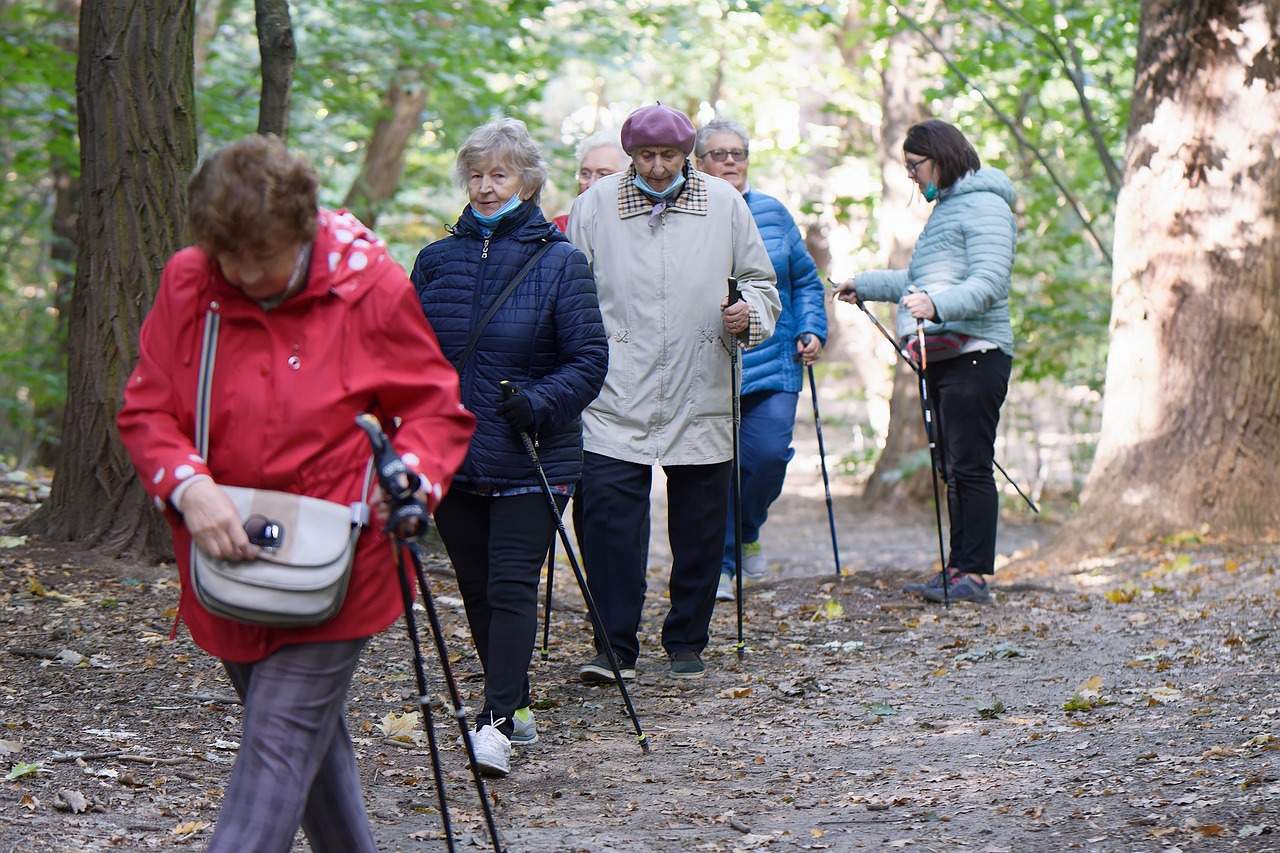
Choosing Pet-Friendly Accommodations
When it comes to traveling with your senior pet, finding the right place to stay is crucial for ensuring both of you have a pleasant experience. Not all accommodations are created equal, and some may not be suitable for the unique needs of older animals. So, what should you look for in a pet-friendly hotel or rental? First and foremost, you want to ensure that the environment is not only welcoming but also safe and comfortable for your furry friend.
One of the key factors in selecting accommodations is accessibility. Senior pets may have difficulty navigating stairs or uneven surfaces, so it’s essential to choose places that provide easy access. Look for hotels with ground-floor rooms or those that offer elevators. Additionally, having outdoor spaces nearby can be a significant advantage, allowing your pet to stretch their legs and relieve themselves without a hassle. Remember, your pet deserves to feel at home, so consider the following:
- Pet Policy: Always check the hotel’s pet policy, including size restrictions and any additional fees.
- Cleanliness: Look for accommodations that maintain a high standard of cleanliness, as this can help reduce allergens and keep your pet healthy.
- Quiet Environment: A calm atmosphere can help minimize stress for your senior pet. Choose locations that are away from noise and heavy foot traffic.
Another important aspect is the availability of pet-friendly amenities. Some hotels offer special services for pets, such as pet beds, bowls, and even treats! These little touches can make a world of difference in your pet’s comfort. Furthermore, consider bringing along some of your pet’s favorite items, like their bed or toys, to create a familiar environment. This can help ease any anxiety they might feel in a new setting.
Lastly, don’t hesitate to read reviews from other pet owners. Websites and apps dedicated to pet-friendly travel often provide insights into the experiences of others. Look for comments about how accommodating the staff is and whether other pets seemed comfortable in the space. This research can save you from potential headaches and ensure that you find the perfect spot for your senior companion.
Q: What should I do if my pet has special needs?
A: If your senior pet has specific requirements, such as medications or dietary restrictions, make sure to communicate these to the accommodation in advance. Many places are willing to accommodate special requests if they are informed ahead of time.
Q: Are there any additional fees for bringing my pet?
A: Many pet-friendly accommodations charge a non-refundable cleaning fee or a daily pet fee. It’s essential to check the hotel’s policy before booking to avoid any surprises.
Q: How can I help my pet adjust to a new environment?
A: Bringing familiar items, such as their bed, favorite toys, and even some of their regular food, can help your pet feel more comfortable in a new space. Additionally, maintaining their routine as much as possible can ease the transition.
Assessing Accessibility
When it comes to traveling with senior pets, accessibility is a key factor that can significantly affect their comfort and well-being. Imagine trying to navigate a maze of stairs or narrow hallways with a pet that has mobility issues—it's enough to make anyone's stress levels soar! Therefore, before booking your accommodations, take a moment to assess how friendly the environment is for your furry friend.
First and foremost, look for pet-friendly hotels that specifically mention accessibility features. This includes ramps instead of stairs, as well as elevators if you're staying in a multi-story building. You want to ensure that your senior pet can move around freely without the risk of injury. Additionally, consider the proximity of your room to outdoor spaces. Is there a grassy area nearby for bathroom breaks? Easy access to these areas can make a world of difference for your senior pet.
It's also essential to check the layout of the hotel room itself. A spacious room can provide your pet with the freedom to move around comfortably, while a cramped space can lead to anxiety and discomfort. When you arrive, take a moment to assess the environment. Are there any obstacles that could pose a challenge for your senior pet? For instance, heavy furniture or sharp corners might be difficult for them to navigate.
In addition to physical accessibility, consider the emotional comfort of your senior pet. Bringing along familiar items, such as their favorite blanket or bed, can help create a sense of security in an unfamiliar place. The more you can mimic their home environment, the more relaxed they will be. Remember, a happy pet makes for a happier trip!
To help you assess the accessibility of potential accommodations, here’s a quick checklist:
- Are there ramps or elevators available?
- How close is the outdoor space for bathroom breaks?
- Is the room spacious enough for your pet to move around?
- Are there any obstacles that could be challenging for your senior pet?
By taking the time to evaluate these factors, you can ensure that your senior pet has a comfortable and enjoyable travel experience. After all, their happiness is just as important as yours!
Q: What should I look for in pet-friendly accommodations?
A: Look for ramps, elevators, and easy access to outdoor areas. Ensure the room is spacious and free of obstacles that could hinder your pet's movement.
Q: How can I help my senior pet feel more comfortable in a new environment?
A: Bring familiar items like their bed or favorite toys to create a sense of home. This can help reduce anxiety and make the transition smoother.
Q: Are there any specific hotels known for being senior pet-friendly?
A: Many chains like La Quinta, Best Western, and Kimpton Hotels are known for their pet-friendly policies. Always check their specific pet policies before booking.
Q: How can I assess my senior pet's mobility needs before traveling?
A: Observe how they navigate their home environment. If they struggle with stairs or have difficulty standing for long periods, consider accommodations that minimize these challenges.
Creating a Familiar Environment
This article provides essential advice for pet owners traveling with older animals, ensuring comfort and safety during the journey. Discover practical tips to make the experience enjoyable for both you and your senior pet.
Senior pets have unique needs that differ from younger animals. Recognizing these needs is crucial for ensuring their comfort and well-being while traveling, including health considerations and emotional support.
Preparation is key when traveling with senior pets. This section outlines essential steps to take before departure, including packing necessary items and planning for regular breaks during the trip.
Scheduling a veterinary visit prior to traveling can help identify any potential health issues. Ensuring your senior pet is fit for travel is essential for a smooth journey and peace of mind.
Updating vaccinations and ensuring your pet's medications are packed is vital. This section discusses which vaccines are necessary and how to manage medication schedules while on the road.
Maintaining your senior pet's diet during travel is important for their health. This section covers tips for feeding schedules and food storage while on the go.
Car travel poses specific challenges for senior pets. This section offers advice on creating a comfortable environment in the vehicle and ensuring safety during the journey.
Finding suitable accommodations is essential for a stress-free trip. This section highlights what to look for in pet-friendly hotels and tips for ensuring your senior pet feels at home.
Accessibility is a crucial factor when selecting accommodations. This subheading discusses the importance of choosing places with easy access for senior pets, including stairs and outdoor spaces.
When you arrive at your destination, creating a familiar environment for your senior pet can significantly ease their transition. Just like us, pets find comfort in familiarity. Imagine stepping into a new place without any of your favorite belongings; it can be unsettling! To help your furry friend feel more at home, consider bringing along their favorite blanket, toys, or even a piece of your clothing that carries your scent. These items can provide a sense of security and comfort, making the new surroundings feel less intimidating.
Additionally, try to set up a designated area within your lodging that mimics their usual resting spot. If your pet typically sleeps in a specific corner of your home, recreate that by placing their bed or blanket in a quiet, cozy corner of the room. This small gesture can help them feel more relaxed and encourage them to settle in quickly.
Another effective strategy is to maintain their usual routine as much as possible. Senior pets thrive on consistency, so keeping feeding times, bathroom breaks, and playtime similar to what they are used to can help alleviate anxiety. For example, if your pet is accustomed to a morning walk, try to schedule that at the same time during your trip. This will not only help them feel more at ease but also keep them physically active, which is essential for their overall health.
Lastly, be mindful of the noise level and activity in your accommodations. A bustling hotel lobby or a noisy neighborhood can be overwhelming for a senior pet. Opt for quieter locations whenever possible and consider using white noise machines or calming music to drown out unsettling sounds. This can create a soothing atmosphere that encourages rest and relaxation.
Comfort is paramount for senior pets during travel. This section provides tips on maintaining a soothing environment, including temperature control and providing cozy bedding for rest.
Frequent breaks are essential for senior pets to stretch and relieve themselves. This subheading emphasizes the importance of planning regular stops to keep your pet active and comfortable.
Travel can be stressful for pets, especially seniors. This section discusses how to recognize signs of stress and what to do to keep your pet calm during the journey.
- How often should I stop during a long trip with my senior pet? It's advisable to stop every 2-3 hours to allow your pet to stretch, hydrate, and relieve themselves.
- What should I do if my senior pet shows signs of stress during travel? Recognize signs like excessive panting, whining, or hiding. Offer comfort through familiar items and consider taking breaks to let them relax.
- Can I travel by air with my senior pet? Yes, but check with airlines for their specific policies regarding senior pets, and consult your vet to ensure your pet is fit for air travel.

Keeping Your Senior Pet Comfortable
When it comes to traveling with your senior pet, comfort is not just a luxury; it's a necessity. Think of your furry friend as a grandparent who needs a cozy chair and a warm blanket. Just like humans, senior pets have specific needs that must be addressed to ensure their journey is as pleasant as possible. One of the most important factors to consider is the temperature control in your vehicle or accommodation. Senior pets can be particularly sensitive to extreme temperatures, so make sure to keep the air conditioning on during hot weather and provide warm bedding during colder months.
Speaking of bedding, bringing along a familiar and cozy bed can work wonders for your pet's comfort. It’s like bringing a piece of home with you! A comfortable bed not only provides a safe space for your pet to rest but also reduces anxiety by offering a familiar scent and texture. If your pet has a favorite blanket or toy, don’t hesitate to pack those as well. These items can serve as a comfort blanket during stressful travel situations.
Another critical aspect of keeping your senior pet comfortable is ensuring they have easy access to water and food. Dehydration can be a real concern, especially during long trips. Make sure you have a spill-proof water bowl and offer water regularly, even if your pet doesn’t seem thirsty. When it comes to feeding, try to stick to their regular feeding schedule as much as possible. This consistency will help them feel more at ease. You might want to pack some of their favorite treats to reward them for being such a good travel buddy!
Additionally, consider the layout of your vehicle. If your senior pet is used to having their own space at home, try to replicate that in your car. Use a pet seat cover or a crate that they’re familiar with to create a designated area for them. This can help them feel secure and less anxious during the ride. Remember, safety is just as important as comfort; ensure that they are safely secured in the vehicle to prevent any accidents.
Lastly, don’t forget to plan for regular breaks during your journey. Senior pets need to stretch their legs and relieve themselves more often than younger pets. Aim for a break every two to three hours, depending on your pet’s needs. During these stops, allow your pet to walk around, sniff, and explore a bit. It’s not just about the bathroom break; it’s also an opportunity for your senior pet to engage with their surroundings, which can be a great mood booster.
- How often should I stop for my senior pet during a long trip?
It's best to stop every 2 to 3 hours to allow your pet to stretch, relieve themselves, and hydrate. - What should I bring to keep my senior pet comfortable?
Pack their favorite bed, blanket, toys, and food/water supplies to create a familiar and cozy environment. - Can I give my senior pet medication during travel?
Always consult your veterinarian before traveling to ensure your pet's medications are managed properly while on the road. - How can I tell if my senior pet is stressed during travel?
Look for signs such as panting, whining, or attempts to hide. If you notice these signs, take a break and comfort them.
Regular Breaks and Exercise
When it comes to traveling with senior pets, regular breaks and exercise are not just a luxury—they're a necessity. Imagine being cooped up in a car for hours on end; it can be exhausting for anyone, especially for our furry companions who may have less stamina than they used to. Taking frequent breaks allows your pet to stretch their legs, relieve themselves, and simply enjoy a change of scenery. This is crucial for their physical well-being and can help prevent stiffness and discomfort that often come with age.
As a general rule of thumb, plan to stop every 2 to 3 hours. During these breaks, give your pet at least 15 to 20 minutes to walk around, sniff the grass, and hydrate. This not only keeps them physically active but also mentally stimulated, which is vital for their overall happiness. You might even consider bringing along a favorite toy or ball to encourage a bit of playtime during these stops.
To make the most of your breaks, here are some effective strategies:
- Choose Pet-Friendly Rest Areas: Look for rest stops that welcome pets. Some places even have designated dog parks where your pet can run freely.
- Hydration is Key: Always have fresh water available. Dehydration can sneak up on senior pets, especially during warm weather.
- Monitor Their Energy Levels: Pay attention to your pet's energy and mood. If they seem tired, it might be a sign to take it easy for the day.
In addition to breaks, incorporating some light exercise during these stops can work wonders. A gentle walk can help keep your pet's joints flexible and their spirits high. If your pet is up for it, consider a short game of fetch or tug-of-war. Just be mindful of their limitations and adjust the activities accordingly. Remember, the goal is to keep them comfortable and happy!
Lastly, keep in mind that every pet is different. Some senior pets may require more frequent breaks, while others might be content with fewer stops. Pay attention to their cues, and adjust your travel schedule to accommodate their needs. By prioritizing regular breaks and exercise, you'll not only enhance your pet's travel experience but also strengthen the bond you share during your adventures together.
Q: How often should I take breaks when traveling with my senior pet?
A: It's best to stop every 2 to 3 hours for at least 15 to 20 minutes to allow your pet to stretch, relieve themselves, and hydrate.
Q: What should I bring for my senior pet during breaks?
A: Bring fresh water, a portable bowl, their favorite toys, and perhaps a blanket or bed for comfort.
Q: How can I tell if my senior pet is stressed during travel?
A: Signs of stress may include panting, whining, pacing, or hiding. If you notice these behaviors, it’s a good idea to take a break and reassure them.
Q: Is it okay for my senior pet to exercise during breaks?
A: Yes! Light exercise is beneficial, but be sure to monitor your pet's energy levels and avoid overexertion.
Monitoring Stress Levels
Traveling can be a thrilling adventure, but for our senior pets, it can also be a source of significant stress. Just like us, our furry friends can feel anxious when faced with new environments, long car rides, or unfamiliar faces. As a responsible pet owner, it's crucial to monitor your senior pet's stress levels throughout the journey. But how do you recognize when your beloved companion is feeling overwhelmed?
First, look for common signs of stress in your pet. These may include excessive panting, drooling, pacing, or even hiding. If your pet starts to whine or bark more than usual, it might be a signal that they are feeling uneasy. Pay close attention to their body language; a tucked tail, flattened ears, or wide eyes can indicate discomfort. By being aware of these signs, you can take proactive measures to help ease their anxiety.
When you notice stress signals, it's essential to act quickly. Here are some strategies to help calm your senior pet:
- Provide a Safe Space: Create a cozy spot in your vehicle where your pet can retreat. A familiar blanket or their favorite toy can make a world of difference.
- Use Calming Products: Consider using calming sprays, pheromone diffusers, or even anxiety wraps designed for pets. These can provide comfort during stressful situations.
- Maintain a Routine: Try to stick to your pet's regular feeding and bathroom schedule as closely as possible. Familiar routines can provide a sense of security.
Additionally, regular breaks during your travels are essential. Not only do they allow your pet to stretch their legs and relieve themselves, but they also provide an opportunity for them to decompress and refocus. During these stops, take a moment to check in with your pet. Offer them some water, a light snack, and plenty of love. This can help reinforce a sense of calm and connection.
Lastly, always keep your vet's contact information handy, just in case your pet's stress escalates to a point where professional help is needed. Remember, your pet relies on you to ensure their well-being, so being attentive to their emotional state is just as important as monitoring their physical health. By taking these steps, you can create a travel experience that is not only enjoyable for you but also comfortable and stress-free for your senior pet.
1. How can I tell if my senior pet is stressed during travel?
Look for signs such as excessive panting, drooling, pacing, whining, or hiding. Changes in body language, like a tucked tail or flattened ears, can also indicate stress.
2. What can I do to help my pet feel more comfortable during the trip?
Provide a safe space in your vehicle with familiar items, use calming products, maintain their routine, and take regular breaks to allow them to stretch and relax.
3. Should I consult my vet before traveling with my senior pet?
Yes! A pre-travel vet check-up can help identify any potential health issues and ensure your pet is fit for travel.
Frequently Asked Questions
- What should I do to prepare my senior pet for travel?
Preparing your senior pet for travel involves several key steps. First, schedule a veterinary check-up to ensure your pet is healthy enough for the journey. Make sure to pack their medications, food, and any comfort items like their favorite blanket or toys. Planning for regular breaks during the trip is crucial to allow your pet to stretch and relieve themselves.
- How can I keep my senior pet comfortable during the trip?
Keeping your senior pet comfortable is all about creating a soothing environment. Ensure the temperature in your vehicle is comfortable and provide cozy bedding for them to rest on. Regular stops for exercise and bathroom breaks will help them stay relaxed and comfortable throughout the journey.
- What signs should I look for to monitor my pet's stress levels?
It's important to be vigilant about your senior pet's stress levels while traveling. Look for signs such as excessive panting, whining, or attempts to hide. If you notice these behaviors, try to create a calm environment by speaking softly to them, offering treats, or taking a break from travel to allow them to relax.
- Are there specific accommodations I should look for when traveling with my senior pet?
When selecting accommodations, prioritize pet-friendly hotels that offer easy accessibility, such as ground floor rooms or places without stairs. Look for amenities that can make your pet feel at home, like outdoor spaces for walks and areas where they can relax comfortably.
- How can I maintain my senior pet's diet while traveling?
Maintaining your senior pet's diet during travel is essential. Stick to their regular feeding schedule as much as possible and pack their usual food in airtight containers to keep it fresh. If you're traveling for an extended period, consider bringing along some of their favorite treats to help keep their spirits up.

